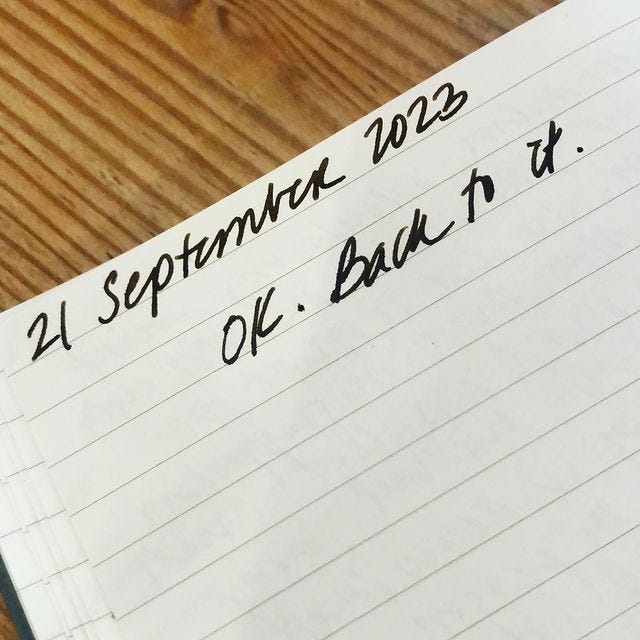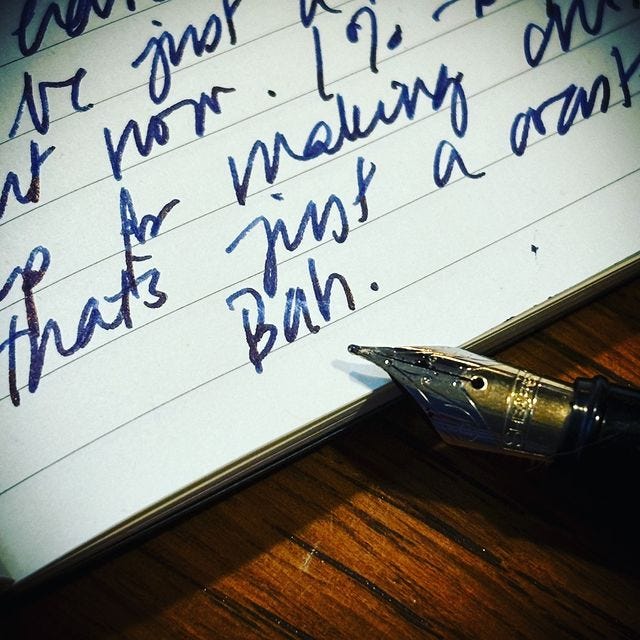This fall, I spent three evenings with a lovely group of ladies who wanted to build their journal habits. I’ve maintained a morning pages practice since 2018. It is not a glorious, sexy thing. Many mornings, those pages are something to plod through. There is no taking flight or finding inspiration, just putting in the time and doing the work of filling three pages, one word after the other, watching the end of my third page get closer and closer and closer.
Exhibit A:
Exibit B:
If you’re familiar with morning pages, you know about Julia Cameron and her book about rediscovering your creativity, The Artist’s Way, in which she prescribes a strict regimen of three pages, free hand, every morning, before you’re fully awake plus an Artist’s Date with yourself every week. It works, but it’s also daunting. Along the way, a few other journaling gurus have helped me tremendously and here they are for you!
Austin Kleon of Steal Like an Artist
If you aren’t subscribing to Austin Kleon’s free Substack newsletter, go ahead and do that now. It’s a list of ten things every week and I always find something interesting there. Kleon journals like his life depends on it. In fact, he keeps three daily journals along side his pocket notebook.
A logbook
A pocket notebook for scribbling
I particularly love looking at his diaries when he shares a few pages. He does something graphic every day and he manages to make this work compliment his writing work. His innovation is finding a way to productively combine the written word with the visual to lead to something more. He’s not switching modes when he moves between words and image, but allowing these two seeming disparate things feed each other. It works, he’s super productive.
Check out his work for ideas about how you can incorporate cutting and pasting, silly drawings, and black out poetry into your journal practice. His diary walk through videos are amazing. And he also writes about using the act of writing the date as a warm-up. Everything can be part of your process.
Lynda Barry and Writing the Unthinkable
Austin Kleon led me to Lynda Barry, who is a gem because of how firmly she believes that all of us are artists and that all of us can draw and that creativity is essential to life. My first encounter with the great lady was via this video, which is still one of my favorites. First of all, can we appreciate how easily she writes backwards? and legibly?!
I love the idea that the journey to writing in our journals is through our senses. If the blank page is staring at you, one thing you can always do is start with what do you see, hear, feel, taste, touch? Every time we describe a thing, our brain associates to the next thing on its own and before we know it, we’re off.
Today, I’m sitting at my desk and it’s been moved so that I am sitting almost in front of the window. It’s cooler here since it’s winter in Alberta and windows can only do so much work. But it’s bright outside today. It snowed last night. Not a lot of snow, but the first snow that looks like it might stick. Alberta just had the first November in 100 years without snow and lakes are freezing solid enough to skate on, snow-free. It’s a crazy time to be here. It makes me think of snow drifts up to the eaves in our house in South Dakota. That was the opposite of this.
[pause]
That’s how these things can go if you start with what’s in front of you and then see what your brain produces. And what your brain produces will be different to what my brain produces and therein lies the beauty of writing and creativity. That’s how you’re an original just by doing.
The Intensive Journal Program
A few years ago, the internet rabbit hole lead me to Intensive Journaling. It was a time of massive transition. We’d just moved to Canada mid-pandemic after 17 years in the Netherlands. I was still an immigrant but also seeing things in the shops that were familiar. We were in a rental home with some of our old furniture but no mattresses. I was unsure what to do next, how this next series of years would fit into the story of my life.
This exercise (it’s a 45 minute video) convinced me that the program would be right for me.
Intensive journaling ended up being a way for me to dive deep into my why, called there my life work. Not the thing you need to do to survive, but the thing you need to do to thrive. It was an intense program, three consecutive workshops, each two days of writing. It involved a binder with many, many dividers that has since become two binders. Afterwards, I continued working for a while with fellow journals from my program. Intensive journaling is a major time commitment, but productive. If you’re at a place in your life where you feel a need to look back so that you can look forward and have the time and energy to commit to this program, I recommend it.
No Right Way to Journal
There is no right way to journal. Everyone has different journaling needs and the most important thing you must do as someone who journals is to make sure you are benefitting from your journal practice. The possibilities are endless, but I hope these three videos will help you find new ways to look at and work in your journal if you’re feeling even a wee bit stuck.



